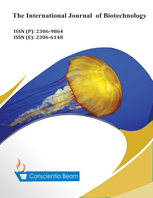Extraction and Purification of L-Asparaginase Produced by Acinetobacter Baumannii and their Antibiofilm Activity Against Some Pathogenic Bacteria
DOI:
https://doi.org/10.18488/journal.57/2016.5.1/57.1.7.14Abstract
L-asparaginase is an enzyme catalyzing the hydrolysis of L-asparagine and formation of L-aspartate and ammonia and widely used as anticancer drug in pharmaceutical and food industry. This amino acid (L-asparagine) has an important role for development of cancerous, in contrast the normal cells don’t need this amino acid. Eight Acinetobacter baumannii isolates of were isolated from different blood and sputum samples and it was found that high isolation rate of Acinetobacter baumannii isolates from sputum was consisted with their association with lower respiratory tract infections. All these eight isolates were screened for higher L-asparaginase production and found that among all these isolates, Acinetobacter baumannii Sp3 gave higher asparaginase activity of 7.32 U/ml. L-asparaginase was purified to homogeneity by sequential chromatographic steps involved ammonium sulfate at 45% saturation followed by DEAE-cellulose ion exchange chromatography and sephadex G-100 gel filtration chromatography with a recovery yield of 68% and 22.65 fold of purification. L-asparaginase had antibiofilm activity against all tested biofilm forming pathogenic bacteria (Escherichia coli, Pseudomonas aeruginosa, Klebsiella pneumoniae, Staphylococcus aureus and Acinetobacter baumannii) after using Congo red agar and Microtitration plates methods for detecting biofilm formation ability. Highly antibiofilm of L-asparaginase recorded against Klebsiella pneumoniae followed by Pseudomonas aeruginosa with reduction of biofilm formation ratio to 32 and 41% ,respectively compared with (100)% of control. Thus we can conclude that L-asparaginase has promising benefit as antibiofilm agent against biofilm forming pathogenic bacteria that have multidrug resistance.

